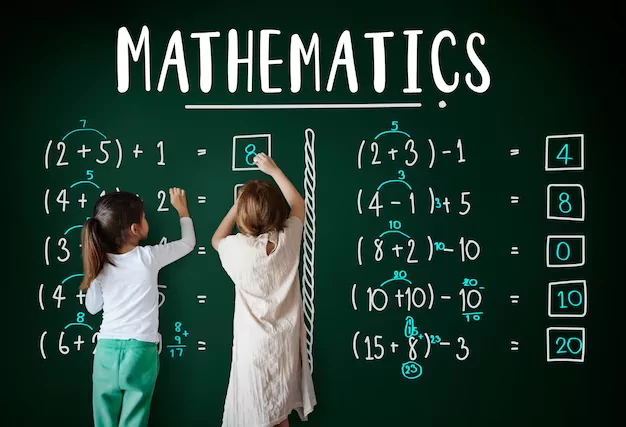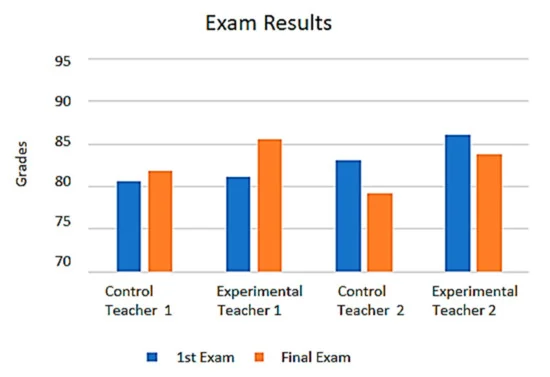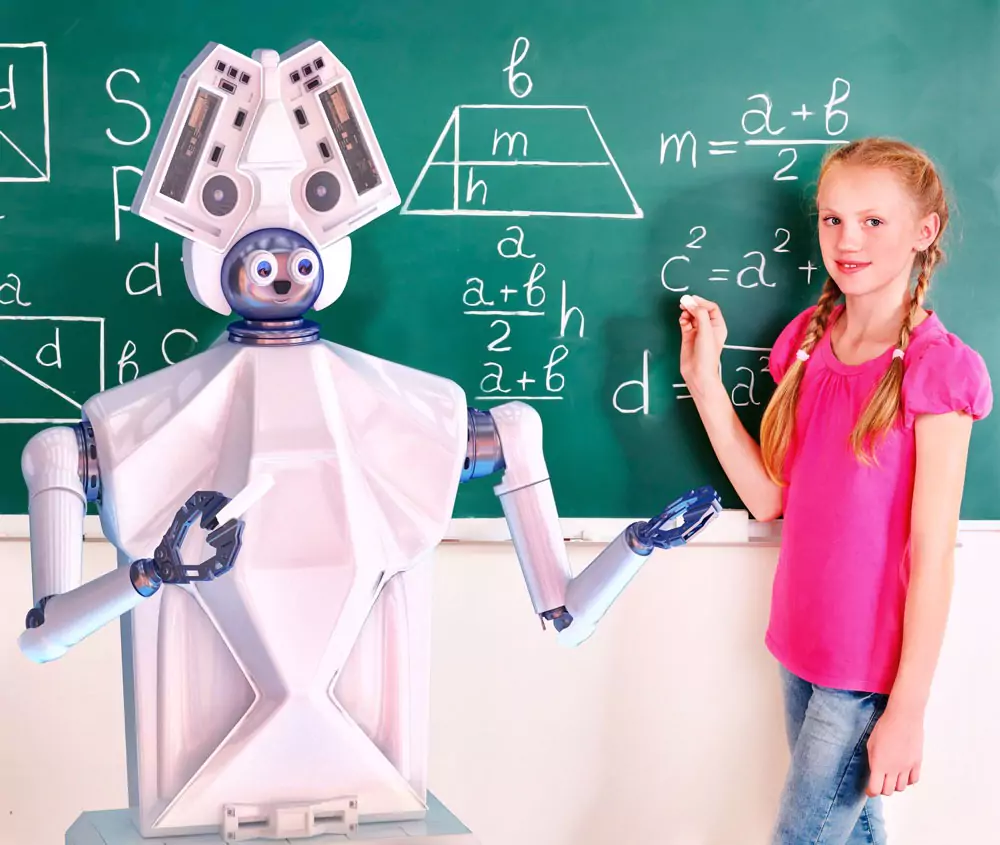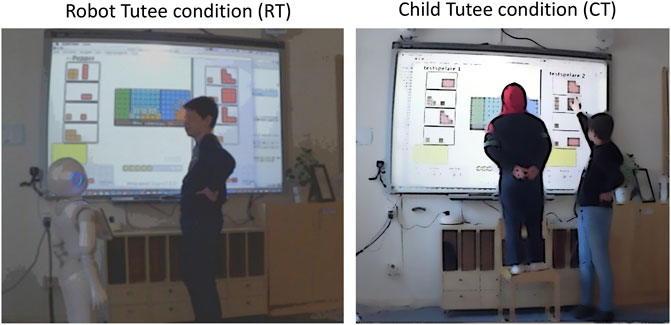Update: This article was last updated on 29th November 2024 to reflect the accuracy and up-to-date information on the page.

A 2020 study, a part of MDPI’s Active Methodologies for the Promotion of Mathematical Learning special issue, unveiled the symbiotic relationship between robotics and mathematics in children’s learning, showcasing significant benefits.
The study demonstrated that technology incorporating active learning strategies, such as robotic support, can help students develop a deeper understanding of math concepts—including geometry, measurement, and algebra—while enhancing problem-solving and critical thinking skills.
The below figure from the study analysis reveals the results of the exam conducted at the high school grade at the end of the semester.
In all cases, the experimental groups’ results are higher than those of the traditional group. This highlights the effectiveness of mathematics in robotics and the potential of integrating math for robotics into educational practices to foster deeper comprehension.
By using robotics math as a teaching tool, students can explore practical applications of math in robotics, reinforcing their understanding of mathematics for robotics concepts and their real-world relevance. The study showcases the growing importance of math robots in transforming how students engage with mathematical ideas. This emphasis on practical applications should excite and engage educators.
Conclusively, the students scored higher with Robotic Support – NAO.

Source: mdpi
Why are we sharing this study with you?
Because we are truly fascinated by the potential of technology in simplifying the most complex subject ever: mathematics, this study shows that incorporating technology, like robotics, into math education can break the cycle of negative attitudes toward math and help students develop a deeper understanding of math concepts. The integration of mathematics in robotics demonstrates how practical applications can make learning more exciting. Robotics math provides students with hands-on opportunities to explore math in robotics while solving real-world problems.
Maths in robotics not only enhances logical reasoning but also bridges the gap between theory and practice. We believe that this and other similar studies hold great promise in inspiring educators to adopt innovative teaching methods, like using math robots, to make mathematics more engaging, enjoyable, and accessible to all students. Mathematics for robotics is paving the way for a future where math for robotics plays a central role in shaping the engineers and innovators of tomorrow.
Maths helps in Robotics

Math is like a toolbox for robots. It helps them understand and move around in the world.
- Algebra is like a code book for robots. It helps them solve problems and make decisions.
- Geometry is like a map for robots. It helps them know where they are and where they’re going.
- Statistics is like a report card for robots. It helps them track their progress and improve their performance.
- Calculus is like a teacher for robots. It helps them learn new things and adapt to new situations.
It’s important to note that mathematics is the key to making robots intelligent and valuable, underscoring its crucial role in robotics.
Methods and Material Required to Use Robotics in Mathematics Learning
From elementary school to graduate school, robots have become valuable educational resources. They play a crucial role in developing a creative mind in math and science, especially in understanding mathematics and robotics. To include math in robotics learning, educators or schools need access to appropriate robotic hardware and software, as well as suitable mathematical learning materials. The two robots dominating the landscape of education in the current times are designed to make math for robotics engaging and accessible.
With the help of a math robot, students can explore robotics math concepts interactively, bridging the gap between theory and application. Emphasizing mathematics for robotics allows learners to develop analytical and problem-solving skills while fostering innovation in STEM fields.
1. Play I Robots
Play-i robots, Bo and Yana, are designed to make programming concepts more accessible to children. Bo comprises four spheres that kids program to move around the floor and deliver small items while avoiding obstacles. Yana, on the other hand, is a single sphere with sensors.
The robots connect wirelessly to mobile devices using Bluetooth 4.0, allowing kids to program them to react to objects in their environment. The open-ended and free-play interaction with the robots encourages children to think collaboratively. The use of mathematics in robotics, such as measuring distances, calculating angles, and programming precise movements, enhances the learning experience.
The robots are used in learning activities such as hide-and-seek, racing, mazes, and programming scenarios, introducing kids to concepts of robotics math in fun and engaging ways. Play-i robots are expected to be available by the end of the year and are intended to be used in math learning classes as engaging educational tools. These robots also demonstrate how math in robotics can make concepts tangible, helping children see the practical applications of maths in robotics.
Whether it’s understanding geometry for programming paths or simple equations for timing actions, math for robotics becomes an integral part of their interaction. Such tools are an excellent way to introduce kids to mathematics for robotics interactively and excitingly.
2. RobotsLAB Box
The material and methods used may vary depending on students’ grade levels and interests. Still, they could involve designing and implementing interactive math games or exercises that incorporate robotics.
This can also include using robots as a teaching tool to illustrate mathematical concepts or developing collaborative learning activities that involve both human students and robots.

Source: frontiersin
The above picture is from a small-scale field experiment in a Swedish school, where sixth-grade students were asked to tutor third-grade students and robot tutees in a separate session. The tutoring task consisted of playing a mathematical game targeting conceptual reasoning. Popular Frameworks to Use Robotics in Mathematics Learning
Popular Frameworks to Include Robotics in Mathematics Classes

Here are some popular frameworks that can be used to incorporate robotics into mathematics learning:
1. Project-based learning:
This involves designing hands-on projects that allow students to apply mathematics in robotics in real-world contexts. For example, students could explore robotics math by programming a math robot to calculate the area of a room or create a visual representation of geometric shapes. These activities showcase the importance of math in robotics, blending concepts like geometry, algebra, and calculus to develop practical solutions. By integrating mathematics with robotics, students gain a deeper understanding of how maths in robotics plays a crucial role in problem-solving and innovation.
2. Inquiry-based learning:
In this framework, students interact with math robots to ask questions, make observations, and draw conclusions about mathematical concepts. Teachers can use robots to create open-ended inquiry activities, encouraging students to explore math in robotics through experimentation and discovery. By integrating mathematics into robotics, students gain hands-on experience applying math to robotics concepts like geometry, algebra, and measurements, fostering deeper learning. This approach highlights the connection between mathematics for robotics and real-world applications, making learning engaging and impactful.
3. Collaborative learning:
This approach emphasizes working in teams, with robots serving as collaborative partners in the learning process. Students can collaborate to design and program robots to solve math problems or create interactive math games that foster teamwork and communication. This integration of mathematics in robotics helps students apply concepts of math in robotics practically, enhancing their understanding of math for robotics. Using a math robot or exploring mathematics for robotics, students develop critical thinking and problem-solving skills while engaging in innovative learning backgrounds.
4. Problem-based learning:
Here, students are presented with real-world math problems that can be solved using mathematics in robotics. Students use robots to collect data, analyze patterns, and develop solutions to complex problems, showcasing the practical application of robotics math. This approach highlights the significance of math in robotics, enabling learners to understand how math in robotics powers technology. By engaging with math for robotics, students gain hands-on experience with a math robot, making mathematics for robotics both interactive and impactful.
5. Game-based learning:
This involves using robotics and math to create interactive games that make learning more engaging and fun. Students can explore mathematics in robotics through activities involving concepts like geometry, measurement, and algebra while also developing programming and problem-solving skills. By integrating math for robotics and playful learning, these math robots provide an exciting way to master mathematics for robotics applications.
Overall, these frameworks provide educators with various approaches for integrating robotics into math instruction, making learning more productive.
Conclusion
After reading about the potential of using mathematics in robotics, it’s clear that technology can be a powerful tool in breaking down barriers and fostering a deeper understanding of mathematical concepts. With creativity and innovation, educators can integrate math in robotics to inspire a love for math in students while equipping them with skills for the digital age. Moonpreneur’s online math curriculum uniquely combines maths with robotics through hands-on lessons, helping children understand math for robotics, build real-life applications, and get excited about learning with a math robot approach.
You can opt for our Advanced Math or Vedic Math+Mental Math courses. Our Math Quiz for grades 3rd, 4th, 5th, and 6th helps in further exciting and engaging in mathematics with hands-on lessons.


























Get your kid involved in activities that involve making decisions and managing their time, like making a plan for the week, setting aside time for studying, and tidying up their stuff. Doing these hands-on activities helps reinforce the idea of prioritization.
Your son can improve his skills in fields like measuring, algebra, geometry, and problem-solving. Along with encouraging critical thinking and logical reasoning, robotics also fosters expertise in mathematics.
Right now is okay but what are the long-term benefits of teaching mathematics to kids via robotics?
Long-term benefits include improved interest in STEM fields, enhanced problem-solving skills, and more adaptability to technology improvements, all of which help kids get ready for the challenges of the modern world.
How can I as a parent of an 8-year-old help my kid to learn math and robotics?
Encourage your child to explore, give them access to robotics kits that are appropriate for their age, and encourage them to learn together. Encourage your child to have a positive attitude towards math and technology to encourage their curiosity and self-assurance.